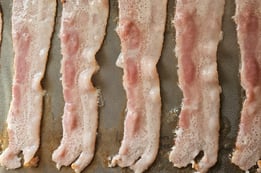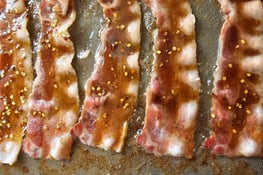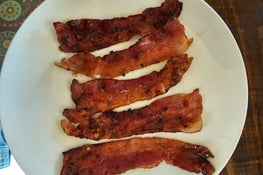Billionaire's Bacon
The Love of Bacon: Bacon may very well be the most beloved of all breakfast staple, but when you brush it with maple syrup and brown sugar, it transforms into something other-worldly, something I call billionaire’s bacon! The combination of fat, sugar, and optional spices create a perfect balance of flavors and textures. But what is the science behind this mouthwatering masterpiece?
Fat, Rendering and Crisping: Bacon is loaded with fat, and when it hits the hot surface of a griddle, the fat begins to render, the process of melting fat out of the bacon’s connective tissue. This makes the bacon crispy and also allows it to cook more evenly. The griddle’s flat surface ensures that all parts of the bacon maintain good contact with the heat, promoting even rendering and browning.
The Secret to Flavorful Browning: I have mentioned in a previous post the Maillard reaction which, when cooking bacon, creates the rich golden-brown color and deep umami flavor. This chemical reaction occurs between amino acids, from the meat proteins, and reducing sugars from the maple syrup and brown sugar. The Maillard reaction kicks in around 300–350°F, which is why bacon should be cooked at a medium-high temperature rather than extremely high heat. A griddle is the perfect cooking appliance for bacon since it allows you to control the temperature exactly. If the heat is too low, you won’t get that rich, caramelized crust; if it’s too high, the sugars in the syrup can burn before the bacon is fully cooked.
Maple Syrup and Brown Sugar: When maple syrup and brown sugar are mixed together and then brushed onto the bacon, they do more than just add sweetness—they also interact with the Maillard reaction to enhance browning and create a complex depth of flavor. The sugars (both the maple syrup and the brown sugar) in the mixture caramelizes as it heats, adding a layer of crunch and a rich, smoky-sweet taste. Since the mixture is primarily sucrose, it begins to caramelize around 320°F. This is why it’s best to add the syrup partway through the cooking process—too early, and it may burn before the bacon is fully crisped.
Salt, Pepper, and Spices: Salt is crucial in bacon because it interacts with fat and proteins, enhancing their natural flavors. When cooking bacon, salt pulls moisture to the surface, helping to develop an even crisper texture. Pepper adds a mild heat that complements the sweetness of the maple syrup, while other optional spices like crushed red pepper (a personal favorite), smoked paprika, cayenne, or cinnamon can introduce additional layers of flavor. These spices contain volatile compounds that are released as they heat up, adding complexity to the aroma and taste of the bacon.
Thick or Thin? Choosing between thick-sliced and thin-sliced bacon for this recipe is ultimately a matter of personal preference. However, there are differences in texture, cooking time, and overall flavor balance that may guide your preference. Thick-sliced bacon offers a meatier texture, making it a heartier option that holds up well to glazing. However, to prevent burning, thick-sliced bacon should be cooked at a lower temperature (325°F) than thin-sliced bacon, sometimes taking up to twice as long to reach the ideal crispiness. The longer cooking time allows for better caramelization, giving the maple syrup more time to infuse the bacon. The extra thickness retains more moisture, creating a nice contrast between crispy edges and a tender, slightly chewy center, though the extra thickness also means less overall crunch. Thin-sliced bacon, on the other hand, cooks quickly, making it a great choice if you want your bacon ready in minutes. It develops an extra crispy texture since it has less fat and cooks at a faster rate. The thin structure allows the syrup to coat more of the bacon’s surface, maximizing the balance of sweet and salty flavors. It is also a good option when layering bacon in a sandwich or using it as a garnish, as it is easier to bite through. However, thin slices are more prone to burning, going from perfectly crisp to overcooked in a matter of seconds, especially with the added sugars. Thin-sliced bacon also lack the chewy, meaty bite of thick-cut bacon.
Griddle Me This: A griddle provides a wide, flat cooking surface that ensures the bacon cooks evenly and stays in close contact with the heat. Unlike frying in a pan, where bacon often curls and cooks unevenly, a griddle allows for a consistent sear across the entire strip. Additionally, the rendered fat has room to spread out, reducing the likelihood of overly greasy bacon and facilitating the crisping process.
The Cooking Process - Step-by-Step:
1. Preheat the griddle to about 325°F for thick-sliced or 350°F for thin-sliced bacon to ensure an optimal Maillard reaction and caramelization.
2. Lay the bacon flat, ensuring each piece has good surface contact for even cooking. Leave at least a half slice of space between each piece of bacon.
3. Let the fat render for a few minutes before flipping, allowing the bacon to develop a crispy base. I recommend draining some of the rendered fat (especially for thick-sliced bacon) to facilitate the crisping process
4. Halfway through cooking, brush with the maple syrup and brown sugar mixture and add salt, pepper, and any other spices. This timing allows caramelization without burning.
5. Flip and cook until perfectly crisp, letting the sugars continue to form a golden-brown glaze.
6. Remove and drain on paper towels to remove excess fat while preserving the crispy texture. Be careful not to keep the bacon on the paper towels too long as the stickiness may make them difficult to remove.
The Ultimate Flavor Balance: Maple syrup and brown sugar glazed bacon is the perfect example of culinary science at work. The balance of fat, sugar, salt, and spice—combined with the physics of griddle cooking—creates an indulgent, crispy, and flavorful result. Whether you’re making this for breakfast, a sandwich, or just as a delicious snack, understanding the science behind the process will help you achieve the perfect bite every time.
So, fire up the griddle, grab some quality bacon, and start experimenting with different spice blends. And…
Let’s get cooking!






Contact
Subscribe to my eNewsletter
© 2024. All rights reserved.
kellycunningham1021@gmail.com
